
Sun – H-Alpha – February 18, 2010
Sketch and Details by Stephen Ames
I use:
Crayola Cerulean pencil for plage
Crayola Aqua Green pencil for proms
White 20# paper
I scan into photoshop and invert.
Blue skies,
Stephen Ames

Solar Prominences
Sketch and Details by Jeff Young
As the sun is finally attaining some altitude above the trees on my horizon, I decided it was time to wake my Solarscope up from its winter hibernation. There was quite a bit of surface activity on view, but I had neglected to bring out my sketching materials for disk work. No matter, there was a nice prominence complex as well, and I had everything I needed for it.
White Derwent Graphitint pencil on black Strathmore Artagain paper.
Sketched from County Louth, Ireland.
As viewed through 70mm Solarscope h-alpha filter, Tele Vue Pronto, Astro-Physics Barlow, Baader MkV binoviewer and 19mm Panoptics.
Cheers,
— Jeff.
Mars – February 2, 2010 – CM 93° – 100°
Sketch and Details by Michael Rosolina
I made this observational sketch of the Red Planet during a recent break in the wintry weather here. I was happy to catch Mars not long after its closest approach to Earth, while the planet still had an angular diameter of 14 arcseconds. That is as big at Mars will appear this apparition and still pretty small for visual observations.
Seeing the ice cap and signs of atmospheric clouds always reminds me of the similiarities between Mars and our own planet–perhaps why observers are always drawn to train their telescopes on that bright, ruddy dot in the sky.
I made this sketch at the eyepiece using 2B and HB pencils to render the dark albedo features and to make the schematic next to the full drawing. I then came inside and immediately added the color, using orange ochre, yellow, peach, and blue color pencils. After scanning, I added the text and notes.
Mars
Planet
Friars Hill, WV USA
February 2, 2010
Clear skies,
Michael Rosolina
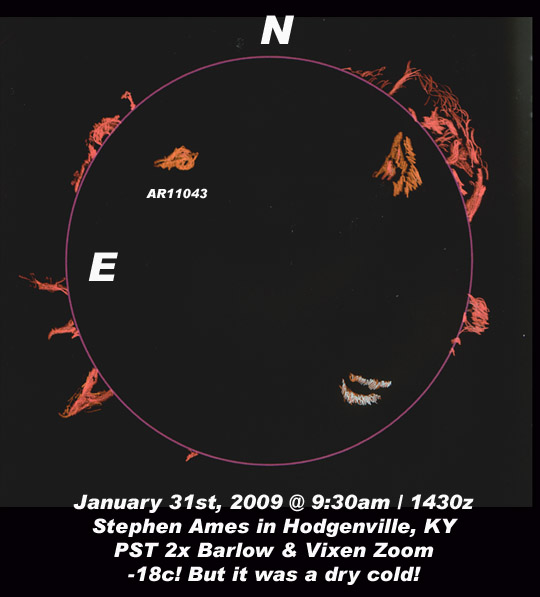
Sun – January 31, 2010
Sketch and Details by Stephen Ames
I use:
Crayola Cerulean pencil for plage
Crayola Aqua Green pencil for proms
White 20# paper
I scan into photoshop and invert.
Blue skies,
Stephen Ames
Hodgenville, KY
See your life giving sun in vivid images and art
from observers all over the world at
www.SeeMySunspot.com
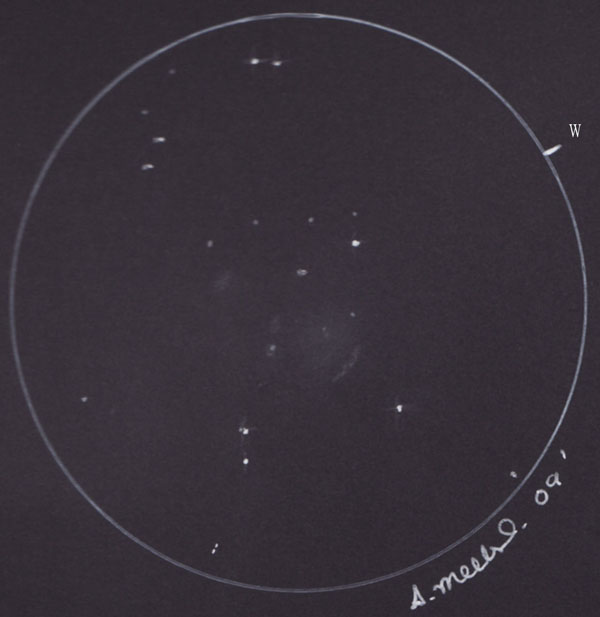
ESO 350-40
Hover mouse over image to view labels
Sketch and Details by Scott Mellish
ESO 350-40
The “Cartwheel Galaxy”
Ring Galaxy
Ilford NSW Australia
13/12/09
56cm f5 Dobsonian telescope
Field: 27′
218x magnification
Sky Quality Meter reading 21:76
Black Canford paper
White oil pencil
White pen
White pastel chalk
The enigmatic Cartwheel Galaxy is a tough enough object to observe let alone sketch.
During a nice clear night in December I made an attempt to sketch it as accurately as possible to the actual eyepiece view, and I was reasonably pleased with the end result.
The trouble with the Cartwheel is that it is quite faint and ill defined in most amateur telescopes, as averted vision is required to capture glimpses of the more subtle features of the object.
To sum up the galaxy is visible as a soft oval glow some 2.0′ x 2.0′ in size, with the two unusual companion galaxies around 1.3′ to the left as can be seen in the sketch.
Another galaxy some 2.0′ above and slightly to the left of the companions was also visible, this galaxy has no relationship with the Cartwheel.
Sculptor was getting a bit low in the west whilst I was doing this sketch, but it was possible during moments of steady seeing and using averted vision to just barely make out the ring structure, but it was very faint.
I could not detect any hint of the “spokes” as seen in the Hubble image, but with a larger scope and steadier seeing they could quite possibly be a chance.
The brighter more active star forming region of the galaxy was discernible as a slightly mottled curved patch some 1.6′ x 0.4′ in size, as can be seen slightly off center to the lower right.
I have included a duplicate reference sketch for those unfamiliar with this elusive and very rare object.
Scott Mellish
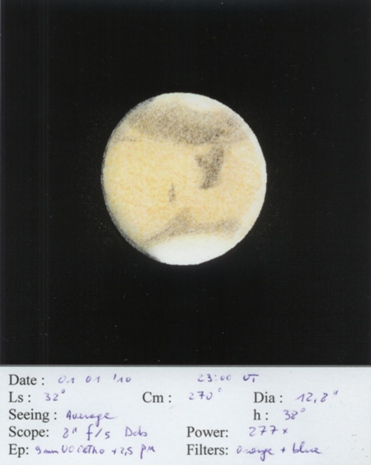
Mars – January 1, 2010
Sketch and Details by Kris Smet
Only average seeing last night, but a few good moments allowed to make a quick sketch!
Syrtis Major looked interesting, the light dessert seemed to run into Syrtis Major just above Moeris Lacus (?) the tip ended with a curved hook to the left. Hellas was the second brightest feature after the polar ice. seeing wasn’t stable enough to see any clouds over Lybia or Aeria though (left and right of Syrtis Major).
The dark plains Utopia and Boreo Syrtis above the NPC. Nodus Alcyonius was also visible at momenst of good seeing, Aetheria wasn’t however.
A lighter region, the division between Mare Cimmerium & Mare Tyrrhenum was quite easy to spot.
I chose to use the 8″ with the fan running during the sketch and an hour before because temperatures dropped to (i guess) 4 or 5°C minus.
Mars is big enough now to allow some great views if seeing cooperates!
01/01/10
location: bornem, belgium
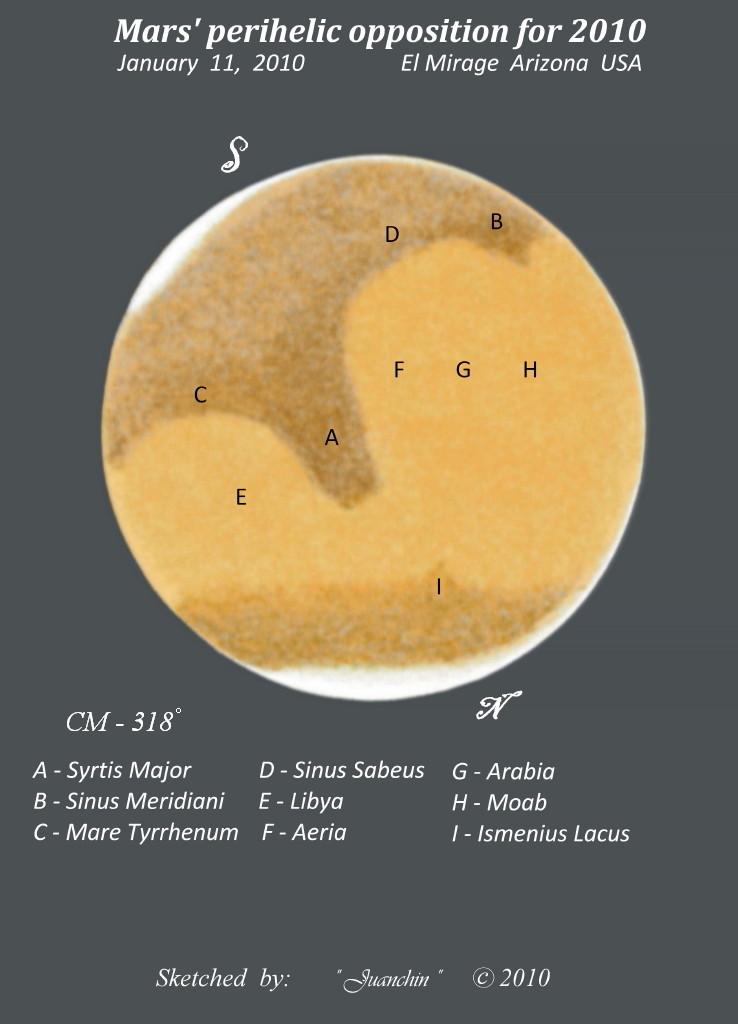
Mars – January 11, 2010
Sketch and Details by Juan Perez (Juanchin)
Object : Planet Mars
Date : January 11, 2010
Time : 23:30 LST / 06:30 UT
Location : El Mirage Arizona USA
Instrument : CPC 1100 / 10 & 7mm Plossl’s
Magnitude : -.7 (Stellarium)
Weather : Chilly night but pleasant, upper 40’s, clear sky!
Mars is an eyecatcher for several reasons; Mars is simply at that time of its orbital cycle where it is closest to Earth and also closest
to the Sun – perihelion. Earth’s position is in the middle thus we say that Mars is at opposition. These two opportunities are not to be
missed, for Mars increases in disc size and becomes brighter by having fuller illumination of its surface by the Sun. For those of us in
the Northern hemisphere, how could you not resist pointing your telescope directly above your head and focus on the orange glowing
planet.
At 13.6 arc-seconds it doesn’t rival its disc size like that of 2003 when it increased to almost twice its size, 25 arc-seconds in
diameter.Even though I lack the eagle vision that a few of you ASOD regulars posses, I was still able to distinguish just a few albedo
features. The South and North polar caps were highly pronounced along with a stretch of bright limb haze around the edge of the disc.
The dark collar which follows the NPC was visible although it varied in its intensity, guessing from turbulence in the Earth’s atmosphere.
The most striking and noticeable dark region was that of Syrtis Major.I spent a few hours trying to work my eyesight in search of any
other subtle details which I ended alphabetizing on the sketch.
Again, Mars is at the center of attention this month and it beckons us to explore its surface details with those optical instruments.
Give it a try, for Mars is looking up! 😀
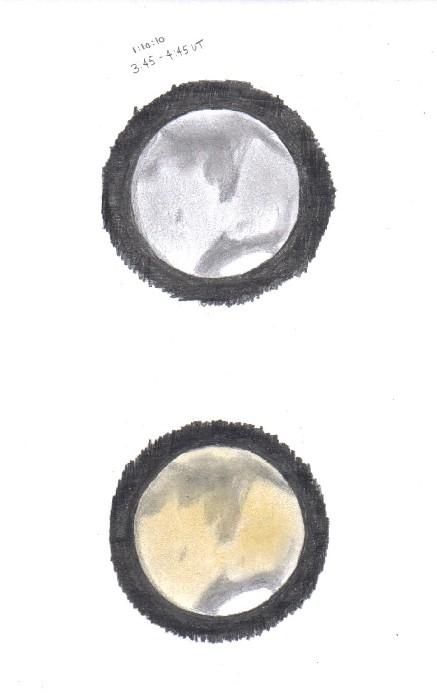
Mars – CM 262 – January 10, 2010
Sketch and Details by Frank McCabe
Mars: January 10, 2010
It was a cold, mostly clear, moonless, night with Mars high in the southeastern sky. Mars was very bright at visual magnitude -1, 98% illuminated and 65.1 million miles from us. The visual diameter of the planet was 13.4″of arc and the central meridian was at 292°.
The first sketch, a graphite drawing, was made at the eyepiece over a one hour interval. When I returned indoors I redrew the sketch in color pencils. When the second colorized sketch matched the eyepiece sketch I stopped and considered it complete.
The seeing was about average (Antoniadi III). Mars is inverted in the sketch and matches the Newtonian view with the north polar cap down and the preceding side to the left.
From top (south) to bottom (north) along the meridian I was able to see with certainty Hellas, Iapygia Viridis, Syrtis Major, Casius and much of Utopia. Also visible in the southern hemisphere were Mare Tyrrhenum, Mare Sepentis, and part of Sinus Sabaeus. In the northern hemisphere I could see intermittently Nodus Alcyonius and Boreo Syrtis.
Sketching:
White sketching paper 8″ x 11″; HB graphite pencil, blending stump for blending orange, brown and yellow Crayola pencil shavings. No adjustments were needed after scanning.
Date 1/10/2010 – Time 3:45-4:45 UT
Telescope: 13.1 inch f/6 Dobsonian and 6mm eyepiece 333x
An UltraBlock Narrowband filter was helpful with some of the fainter features.
Temperature: -17°C (1°F)
clear, calm
Transparency 4/5
Seeing: Antoniadi III
Frank McCabe

H-Alpha Sun – December 29, 2009
Sketch and Details by Stephen Ames
Crayola Cerulean for plage
Conti White pencil for filament
Crayola Aqua Green pencil for proms
white 20# paper with Aqua Green disk
I scan into photoshop and invert.
Blue skies,
Stephen Ames
Hodgenville, KY
http://www.seemysunspot.com/

Mars – CM 313°
Sketch and Details by Kris Smet
Finally some good seeing tonight, i had a beautiful view of syrtis major, hellas, sinus sabaeus and the north polar region. finally some subtle darkness differences in syrtis major could be made out; where mare tyrrhenum runs into syrtis major and the northern tip was dark and kinda triangular. the little ‘bended hook’ was also visible. sinus sabaeus was also a bit darker. after a while i thought to see some irregularity in the npc/nph border, like a bit of it sticking out, slightly isolated.
Lybia & Aeria showed as bright patches, i guess Lybia could be clouded because it showed up brighter in blue light than Aeria.
the deucalionis region (in between sinus sabaeus and noachis) also looked brighter, but i think that might just be due to the it’s position between two darker areas.
Hopefully we can get a few more nights like this in january! it’s good sessions like these which make you forget previous frustrating views
I used my 8″ dob for this one @ 357x without filters.
the sketch is simply scanned and a bit unsharpened, no further color, brightness or contrast enhancements.
location: bornem, belgium